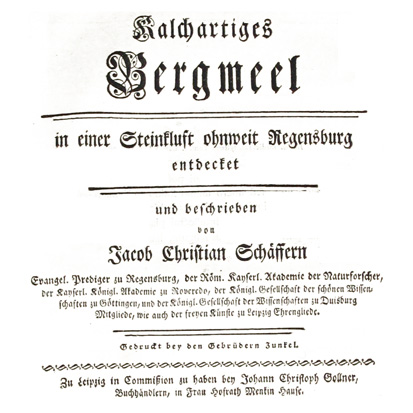SCHAEFFER, Jacob Christian.
(1718 – 1790)
From 1741 Schäffer was a parson of the Evangelical Church in Regensburg. In 1779 he was promoted to a position of superintendent. Schäffer graduated from the University of Tübingen in 1763 with an advanced degree in theology. He wrote on a variety of technological subjects, including electrical phenomena.
Biographical references: ADB. • Biographie Universelle. • DBA: I 1086, 210-248. • Gilbert, Deceased Entomologists, 1977: ??. • Hirsching, Historisch-literarisches Handbuch, 1794-1815. • Meusel, Verstorbenen Teutschen Schrifsteller, 1802-16. • Nouvelle Biographie Générale (Hoefer). • Poggendorff: 2, cols. 768-9. • Schrader, Biographisch Lexicon der Tierärtze, 1863. • WBI.

1. German, 1757.
Kalchartiges | Bergmeel | [double rule] | in einer Steinluft ohnweit Regensburg | entdeckt | [double rule] | und beschrieben | von | Jacob Christian Schäffern | [...4 lines of titles and memberships...] | [double rule] | Gedruckt bey den Gebrüdern Zunckel. | [ornate rule] | Zu Leipzig in Commißion zu haben bey J.C. Gollner, | Buchhändlern in Frau Hofrath Menkin Hause.
4°: [4], 38 p. Page size: 220 x 175 mm.
Rare. This is an early book describing the sources and the important agricultural uses of diatomaceous earth. From the earliest times stored grain has been protected from insects by adding a powder or dust to it. Common materials include plant ash, lime, dolomite, certain types of soil, and diatomaceous earth or Kieselguhr. The last is the subject of this work, which is perhaps the most effective non-toxic natural insecticide.
Diatomaceous earth is a geological deposit made up of the fossilized skeletons of siliceous marine and fresh water organisms, particularly diatoms and other algae. These skeletons are made of hydrated amorphous silica or opal. When crushed, they break up into microscopic pieces with sharp edges. To humans it feels like a talcum powder, but the individual particles are easily picked up in the hairy bodies of most insects, whereupon scratches are made through their protective wax layers. The result is that the insects lose moisture rapidly, dry up and die.
Bibliographical references: Boehmer, Bibliotheca Historiæ Naturalis, 1785-9: 4, pt. 2, p. 193. • Cobres, Deliciæ Cobresianæ, 1782: 2, p. 757, no. 33. • Commentarii Lipsiæ: 8, p. 346. • Erlangische gelehrte Anmerkungen.: 1758, p. 9. • Gatterer, Mineralogischen Literatur, 1798-9: 2, 50. • Göttingische gelehrte Anzeigen: 1757, p. 1213. • Katalog Bergakademie Freiberg, 1879: p. 579 [VI. 479.]. • Leipziger gelehrte Zeitung: 1757, p. 820. • LKG: XVI 124. • NUC: 523, 627 [NS 0178870]. • Zinken's Leipziger Sammlungen: 14, pp. 15-24.
.